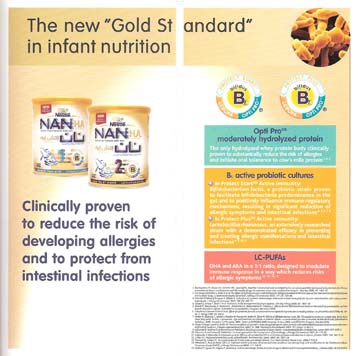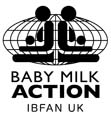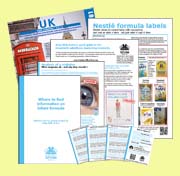Nestle's brave new world. Good Grief!
It has been a busy month for Nestlé as it tries to remake the world in its own image. It culminated in Nestlé announcing "The first comprehensive nutrition system for babies", a machine that squirts out milk into feeding bottles for new borns (click here for our press release and quote). How on earth has the human race survived without there being a way to provide nutrition to its young? In Nestlé's world, the past is prelude and the fact that babies were once nurtured by milk produced by their mothers' bodies is to be consigned to our primitive past it seems. Nestlé, Good Grief!.
 (Left: According to the World Health Organisation: "Powdered infant formula (PIF) has been associated with serious illness and death in infants due to infections with Enterobacter sakazakii." Nestlé does not follow the simple steps in the World Health Organisations Guidelines on how to prepare formula to reduce the risks. Powdered formula is not sterile and Nestlé has had to carry out mass recalls in the past due to intrinsic contamination with harmful bacteria. Highlighting the machine's sealed capsules ignores this fact. The machine reconstitutes formula at a maximum temperature of 40 deg. C, far below the 70 deg. C recommend by WHO to kill any harmful bacteria already present in powdered formula).
(Left: According to the World Health Organisation: "Powdered infant formula (PIF) has been associated with serious illness and death in infants due to infections with Enterobacter sakazakii." Nestlé does not follow the simple steps in the World Health Organisations Guidelines on how to prepare formula to reduce the risks. Powdered formula is not sterile and Nestlé has had to carry out mass recalls in the past due to intrinsic contamination with harmful bacteria. Highlighting the machine's sealed capsules ignores this fact. The machine reconstitutes formula at a maximum temperature of 40 deg. C, far below the 70 deg. C recommend by WHO to kill any harmful bacteria already present in powdered formula).
In the old days, people sometimes talked of the mother-baby pair. Once breastfeeding was established - which sometimes required a little guidance as breastfeeding became an increasingly lost art - the mother would produce milk in response to cues from her child and it would change during the day and over time, tailored to the needs of the child. Milk was available on demand, at the right temperature. In Nestlé’s brave new world, it says of its BabyNes machine:
"The composition of the six consecutive formulas meets the evolving nutritional needs in the first three years of life: four formulas in the first year, and one formula for each of the following two years. The customised composition of these products is tailored to suit the growth pattern in early life and the baby’s changing nutritional needs, while taking into account the steady introduction of solid food into the infant’s diet."
The language has been appropriated. The machine produces milk 'tailored' to the baby we are to believe. Human milk is a living substance and not only adapts in its nutritional content, it is truly tailored to the needs of the baby as the mother’s body produces protective factors in response to infections in the environment, a medicine that is essential for reducing risk of infections. Without breastmilk babies are more likely to become sick and, in conditions of poverty, more likely to die.
Nestlé further extols the virtues of its magical machine thus:
"The single-serve portions are sealed in capsules, used in the proprietary BabyNes machine, which recognises each capsule and prepares the bottle with precisely the right dosage and temperature, at the push of a button, in less than one minute. The BabyNes machine combines state-of-the-art technology with the utmost safety and convenience, and ensures a hygienic, quick and easy bottle preparation."
So we are to believe BabyNes knows how to produce precisely the right dosage. Yet it is a false picture. A breastfed baby takes as much as it needs, not so easy to do when a plastic nipple is held in its mouth, no matter how precisely the volume in it has been decreed by the Nestlé machine.
Most misleading of all is to describe the machine's output as hygienic. The water used to make the formula is not boiled, just filtered. The World Health Organisation recommends all water be boiled, even bottled water. The capsules contain powder, and as they are sealed might appear to offer sterile certainty, but powdered formula is itself not sterile and may contain harmful pathogens such as Salmonella and Enterobacter Sakazakii. Nestlé knows this well as it has had to recall thousands of tins of formula in the past after such contamination has been found in its powder. The US Food and Drug Adminstration has cited a study of tins on the market that found 14% contained Enterobacter Sakazakii, which in rare cases can lead to fatal illness, though there are simple steps to reduce the risks - steps Nestlé’s machine seems not to take.
It was the death of a child in Belgium fed on contaminated Nestlé formula in 2002 that was a catalyst for a World Health Organisation investigation leading to its recommendations on reconstituting powdered formula. This includes reconstituting formula with water above 70 degrees Celsius to kill any harmful bacteria, then cooling the formula. Nestlé says its machine mixes feed in one minute without boiling the water, at a maximum temperature of 40 degrees Celsius.
Baby Milk Action recently produced a film on behalf of the Baby Feeding Law Group called Infant Formula Explained to show how to prepare a bottle in line with WHO guidance - necessary because companies are reluctant to tell parents that powdered formula is not sterile and how to reduce the risks. We have asked Nestlé many times to bring its warnings and instructions into line, and it has refused. Now we know part of the reason why: its machine has been under development for six years and if it acknowledged that formula should be prepared with water above 70 degrees, it would have had to go back to the drawing board.
Instead a potentially dangerous method of preparing formula is being touted as offering the "utmost safety".
In the world of marketing, of course, everything is always new and improved.
 Last year we exposed Nestlé claiming the formula in its tins was 'The new "Gold Standard" in infant nutrition', another attempt to appropriate the language of breastfeeding, long described as the "Gold Standard". After thousands of emails from boycott supporters, Nestlé said it had discontinued the leaflet - after attempting to argue that the 'Gold' referred to the colour of the formula labels.
Last year we exposed Nestlé claiming the formula in its tins was 'The new "Gold Standard" in infant nutrition', another attempt to appropriate the language of breastfeeding, long described as the "Gold Standard". After thousands of emails from boycott supporters, Nestlé said it had discontinued the leaflet - after attempting to argue that the 'Gold' referred to the colour of the formula labels.
The withdrawal of the leaflets was one of four actions highlighted by Nestlé in its response to the Breaking the Rules, Stretching the Rules 2010 monitoring report which profiles the practices of 22 formula and feeding bottle companies with examples of violations from 46 countries.
The report contains page after page of examples of Nestlé materials showing how the company systematically violates the International Code of Marketing of Breastmilk Substitutes and subsequent, relevant Resolutions of the World Health Assembly. Earlier this month I joined Annelies Allain from the International Code Documentation Centre to present the report in Geneva prior to the World Health Assembly (you can watch the film below).
While promising action on just four of these examples - including the ‘Gold Standard’ leaflet - Nestlé defended the rest of the 130 violations it counted in the report.
So Nestlé intends to continue with 97% of the violations exposed.
In Nestlé's brave new world this open contempt for the marketing requirements adopted by the world's highest health policy setting body - which repeated its call last year for companies to meet their responsibilities - is turned on its head. Nestlé cites the fact that it decided only four violations were valid as proof it is doing little wrong - whereas in reality this shows it is doing virtually nothing to put things right (Danone, by contrast, said action it has taken would stop 50% of the violations in its profile and it promised to make other changes such as removing the Immunofortis claims from its formula labels).
Nestlé continues with marketing strategies such as claiming its formula 'protects' babies, with colourful logos on labels and promotion to health workers and mothers. This is despite acknowledging to Baby Milk Action in our ongoing correspondence that actually there is 'no proven benefit' from adding highlighted ingredients such as DHA to formula. Nestlé's argument is that it refers to the benefits of DHA in breastmilk, not in its formula - though whether parents who are drawn in by the logos appreciate this sophistry is debatable.
Where Nestlé does make changes it is either because legislation gives it no choice, or because of campaign pressure. Although Nestlé prefers to invest in diverting criticism, when executives judge bad publicity is fuelling the boycott to too great a degree, or it is bombarded with messages, then it changes policies and practices. Even though Nestlé is one of the four most boycotted companies on the planet, further pressure is needed.
To this end some of us gathered at Nestlé (UK) HQ last Saturday to record some campaign clips that will be available soon. You can already download a Nestlé, Good Grief! jingle as a ringtone - click here.
The boycott means that even in some of the reporting about BabyNes, journalists are questioning Nestlé on violations of the Code.
How Nestlé responds is illuminating. Nestlé told Nutraingredients:
"We have the industry’s toughest system in place to enforce WHO Code compliance. Indeed, we are the only infant formula manufacturer listed by FTSE4Good, the London Stock Exchange’s Ethical Index.”
The first statement is demonstrably false given the systematic way Nestlé violates the Code. The second statement ignores the fact that in order for Nestlé to be listed by FTSE4Good, FTSE changed the criteria in September 2010 (Nestlé was excluded prior to this). Systematically violating the Code on the ground is not an obstacle to being listed and FTSE has not yet conducted any evaluation of Nestlé marketing practices. In Nestlé's brave new world something becomes true just because Nestlé says it is true and FTSE decided to believe Nestlé when it said it had put policies and systems in place to stop violations, rather than monitoring evidence.
Nestlé is promoting its new BabyNes product with a press release, news conference and postings on its website and in social media. However, all forms of promotion of breastmilk substitutes are prohibited by the Code and Resolutions.
If Nestlé tried these tactics in a country that has implemented the Code and Resolutions in legislation it could find itself in court, as Johnson and Johnson did in India in the 1990s for press releasing information about a new feeding bottle. India has exemplary legislation with a sanction of imprisonment for the Managing Director under what is criminal law. Johnson and Johnson apologised and later said it realised it was inappropriate to be marketing feeding bottles in India and discontinued its feeding bottle business. Nestlé has also been taken to court in India, for failing to translate warnings on formula labels. Nestlé continues to fight the case and unsuccessfully took the government to court to have the law struck down on the grounds it was infringing its rights.
All this is as nothing to Nestlé's master stroke last week in tyring to usher in its brave new world. Thirty years after the adoption of the International Code, "top government officials" met to discuss "Future Directions in Nutrition, Water, Rural Development". I'm not talking about the World Health Assembly gathering in Geneva, where the world's health ministries discussed these and other issues such as the growing problem of non-communicable diseases caused by the diets promoted by junk food companies such as Nestlé (for that is what much of its food is, despite its attempt to rebrand itself as a Nutrition, Health and Wellness company).
No, the "top government officials" were in Washington at Nestlé's Creating Shared Value Forum. This was not only an attempt by Nestlé to appropriate the language of development, portray itself and its model as beneficial, and set the policy agenda. It was surely also a shot across the bows of the World Health Assembly, meeting at the exact same time across the Atlantic; a warning that in Nestlé’s brave new world the world’s highest health policy setting body was close to being irrelevant.
In Geneva the Director General of the World Health Organisation, Margaret Chan, was presenting a report to Member States on funding as WHO's budget is being squeezed. The solution the DG proposed is to bring in business by setting up the World Health Forum. Perhaps with an eye on Nestlé's event in Washington she said this would be a "multi-stakeholder forum" which will "identify future priorities in global health".
Baby Milk Action and its partners in the International Baby Food Action Network (IBFAN) and other organisations raised concerns over conflicts of interest. Corporate Accountability International joined us in delivering a letter to Dr. Chan signed by over 100 organizations and individuals from more than 24 countries.
The same week as Nestlé Creating Shared Value Forum, Save the Children Australia, Oxfam, Care and 13 other Aid agencies working in Laos wrote a letter to Nestlé stating that they will not be applying Nestle's Creating Shared Value Prize because the company's continued marketing of formula "still jeopardizes the health of infants and children in Laos." - Click here.
However, we can expect some organisation to accept Nestlé’s money and Nestlé will publicise this as if it is some kind of development agency.
The campaign against Dr. Chan’s proposed partnership with corporations in a World Health Forum continues. The stated aim of the Forum is to “Improve health outcomes, with WHO meeting the expectations of its Member States and partners”.
Well, we already know what Nestlé expects if this partnership goes ahead.
Nestlé wants people to believe that its refusal to act on 97% of the violations of the WHO Code is a good thing and that those experts on the ground who state the company "jeopardizes the health of infants and children" are to be ignored because a FTSE committee sitting in London examining Nestlé’s policy statements and other presentations.
While Nestlé continues to undermine breastfeeding and refuses to warn parents who use formula of the risks, in its brave new world it wants people to believe that thanks to Nestlé the human race has finally been delivered "The first comprehensive nutrition system for babies".
- Webmaster's blog
- Login to post comments






